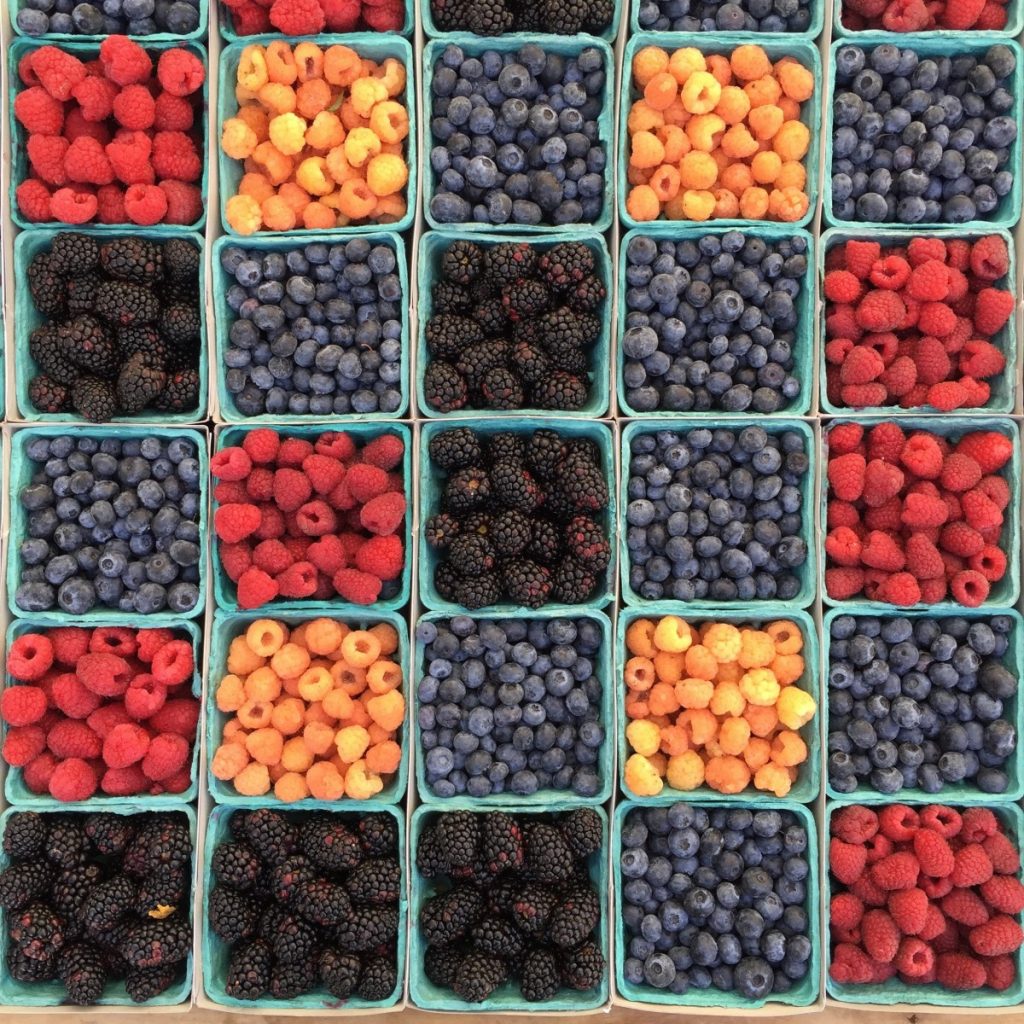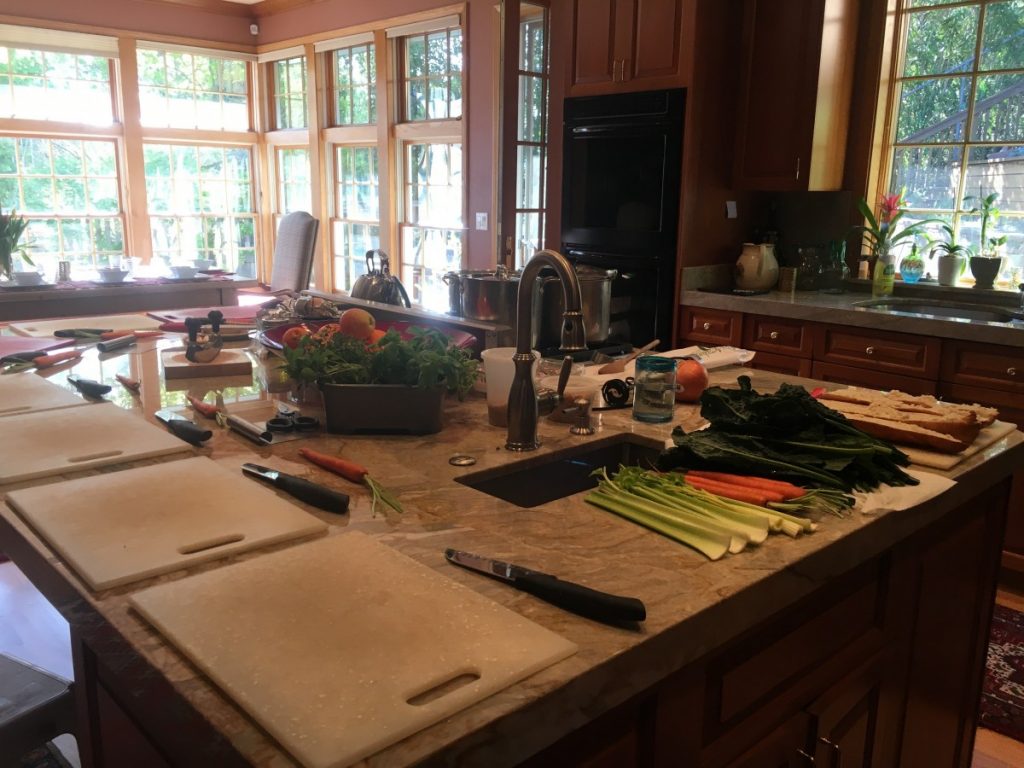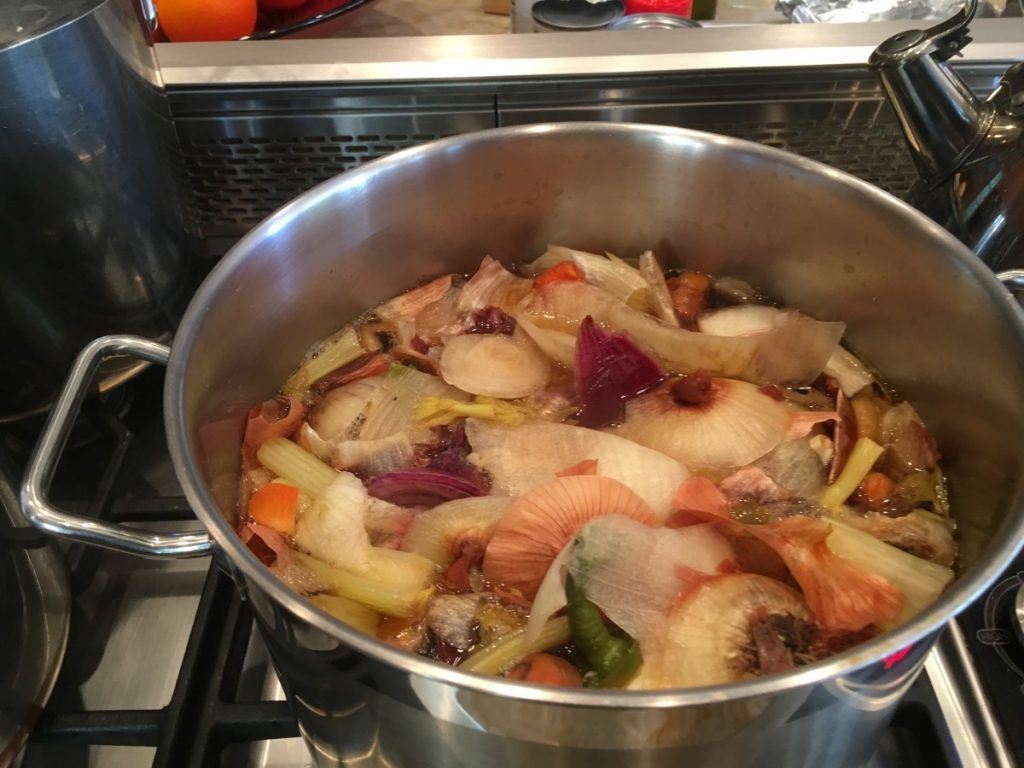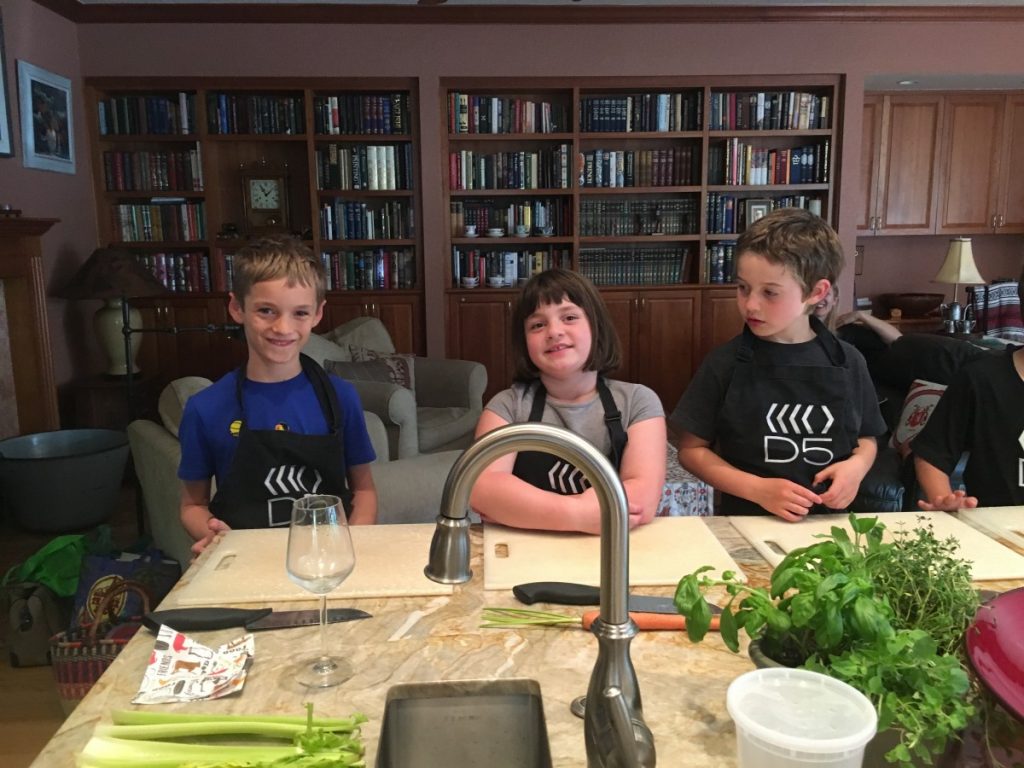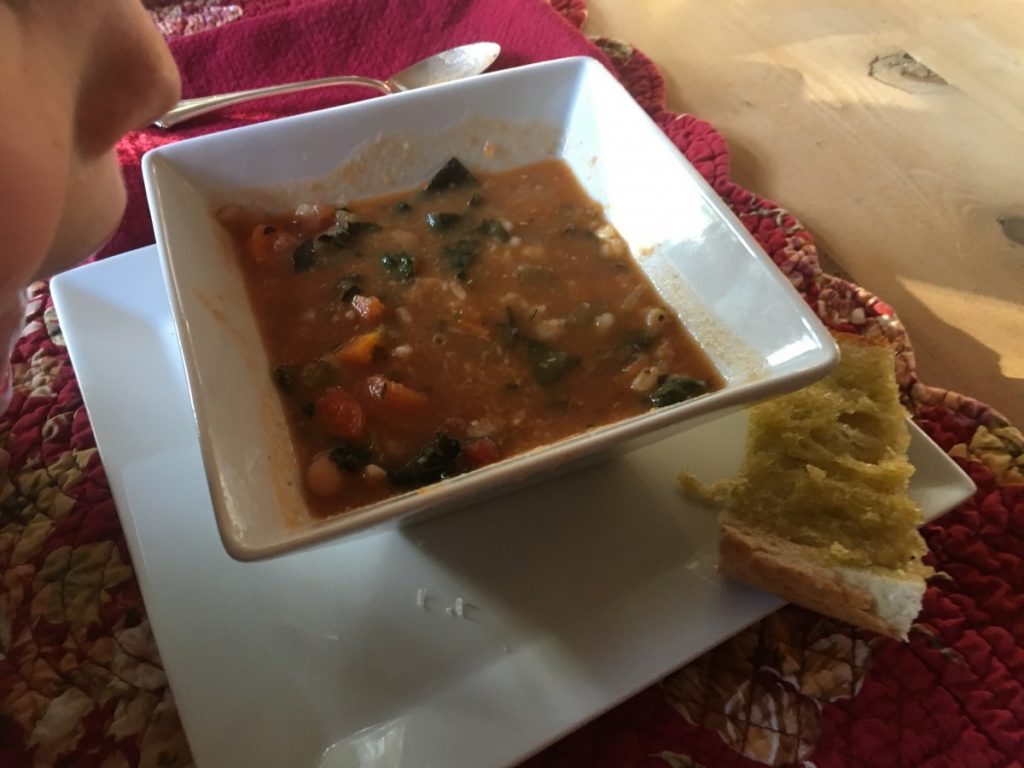Here’s Day 1 of a 5-Day Camp for 6-9 years olds. We have taught this class to many, many kids and they love the food, and especially love knife skills.
Day 1
Introduction:
Healthy Kitchens, Healthy Lives is the mantra for this program.
When you understand the foods that support your health, and then you learn to create sumptuous meals for you and the people in your life, you feel satisfied and contented.
In the Kitchen:
Kids, like most adults, simply want to jump in and make homemade pizza, but there are basics that need to be learned first, for safety and sanitation reasons, of course, but also so one knows how to measure properly, what size and type of pan to use and other basic information needed for a successful kitchen experience.
Safety and Sanitation:
Before you enter the kitchen, tie your hair back if you have long hair, and if you’re sick, stay out of the kitchen altogether. Next wash your hands in warm, soapy water. If you have any cuts or sores, be sure to cover with a bandage. While you’re in the kitchen, if you sneeze, cough, touch your hair, nose or any other body part, or eat, please wash your hands again. You obviously wash your hands well after you use the restroom. If you handle raw meat or fish, please wash your hands before touching any other food. Ideally your clothes and aprons should be clean.
Here are some very important tips to always keep in mind when you’re in the kitchen:
- When you work with food, keep raw foods away from cooked foods.
- Keep food away from cleaning products.
- Wash all raw fruits and vegetables before preparation.
- Rinse off your meats and fish as well, pat dry and leave in the refrigerator until you’re ready to use them. Raw and thawing meats and fish should always be kept on the bottom shelf of the refrigerator to avoid dripping and contamination.
- Do not thaw foods at room temperature; thaw in a proper container in the refrigerator. Do not refreeze food after it’s been thawed.
- Food needs to be held at proper temperatures to avoid the growth of bacteria that can make you sick. Cold foods should be kept at 40 degrees Fahrenheit. Stuffed meat and reheated leftovers should be kept at 165 degrees, beef and other hot food, 140 degrees, fish and poultry, 145 degrees and cooked pork, hamburgers and eggs, 155 degrees.
Kitchens can be dangerous places, with sharp equipment and hot stoves! It was my experience when I had my cooking school that, in order of accidents, potato peelers, graters, knives, and hot stoves and ovens, were the major culprits. With some very basic and very important rules, well learned, accidents rarely happen.
A tip for adults working with kids in the kitchen is to try not to hover. I understand the nervousness about watching an eight-year hold with a knife, but hovering only makes them nervous and makes the kitchen a stressful place, when it should be a warm, nurturing place. When they understand basic kitchen safety and the proper use of equipment such as knives, they’ll be fine.
There is one basic rule when working in the kitchen-stay focused on the job at hand! If you are grating or chopping, your eyes are on that knife and cutting board and nowhere else. When this is learned, accidents rarely happen.
Let’s begin with knives. When choosing a knife, how does it feel in your hand? A ten year old with relatively small hands wouldn’t be comfortable using a twelve-inch chef knife. A good knife can last a lifetime, so choose your knife carefully. A knife store with salespeople who really understand all the intricacies of knives is an invaluable source of information. Here are some basics:
The knife has a blade, which does the cutting. The example, below, is a typical western knife that is sharp on both sides. Japanese knives have blades that are sharp on only one side, as they believe they cut more effectively.
There are various types of blades:
Carbon steel- Our ‘knife –guy’s’ favorite knife because it takes a great edge but discolors when they come in contact with anything acidic like tomatoes or citrus fruit. A carbon knife will rust so be sure to clean and dry them after every use.
Stainless Steel- They don’t rust so taking care of them is much easier, however, they are difficult to keep a good sharp edge.
High carbon stainless steel – Tough, holds an edge and they don’t discolor. The carbon adds strength to stainless but also more cost. A good choice.
Titanium- Much lighter than steel, holds its edge, and is also flexible, so it is a better choice for boning and filleting knives.
The spine is opposite the blade and adds weight and stability. The tip of a knife is at the point and is used for inserting the knife into something and for cutting small items. The tang is that piece of metal that extends from the blade to the back of the knife and the handle attaches to. The tang also gives a knife some weight and balance. Better knives have tangs.
The bolster is that little collar that separates the blade and the handle and adds strength and balance. The bolster can run from the spine to the edge or just part way. You hold onto the handle and it’s important for the handle to feel good in your hand. It can be made out of wood, plastic, composite or stainless steel.
Knives are blocked, forged or sintered.
- Blocked knives are cut from a single sheet of metal usually of the same thickness. Think of using a cookie cutter on rolled dough. The blades are then ground to form the edge and handles are added to the tang. They typically don’t have bolsters and are less expensive to make and therefore buy.
- Forged knives, as the name suggest, are forged, and not stamped. The manufacturer takes metal, heats it up and pounds it into the correct shape using a drop forge machine. These knives typically have bolsters, more weight, and thicker bolsters and cost more to produce. They are better balanced knife that when taken care of properly, can last a lifetime.
- Sintered knives, or Eastern-style knives, is a process where they take a separate blade and fuse it to a separate tang.
Whatever type of knives you choose, you must frequently sharpen them, as a sharp knife is safer than a dull knife. With a dull knife you exert more pressure on the knife, which generally means more accidents. Always hand-wash your knives, dry properly and store where they won’t rub against other knives. Besides a chef’s knife, you will also need a paring knife, which has a short blade and is used for small jobs, a bread or serrated knife, a boning knife for removing meat from joints and a carving knife, for carving and slicing meat.
A few last tips: never try to catch a falling knife! When you carry a knife it should point down and the blade should face backwards. Carry it close to you but not against your body. When you carry your knife to the sink, carry it by itself and not on your cutting board where it could fall. Do not place knives in a sink full of dirty dishes as in retrieving them; you could grab the blade by mistake.
Cutting boards can be made of any number of material, wood, plastic, bamboo or composite, which are various material fused or glued together. Wood boards are the easiest on your knives, but cannot be put in the dishwasher, plastic boards and composite boards can be washed in the dishwasher, but gouges can harbor bacteria, bamboo is a sustainable wood product; whichever you choose, wash it carefully between uses.
Now that you understand more about knives, you need to learn basic knife cuts. The proper knife cut affects cooking time and visual appeal.
Basic Knife Cuts:
Julienne: A stick cut. Strips 2-2 ½ inches long. 1/8” X 1/8”
Brunoise: A dice cut. 1/8” X 1/8” X 1/8”. Made from cutting a julienne.
Batonnet: A strip cut. Strips 2-2 ½ inches long. ¼” X ¼”
Small Dice: A dice cut. ¼” X ¼” X ¼”. Made from cutting a Batonnet.
Medium Dice: A dice cut. ½” X ½” X ½”.
Large Dice: A dice cut. ¾” X ¾” X ¾”
Mince: Small cut with no specific dimensions made by rocking the knife back and forth.
Chiffonade: Stacked leaves, rolled up, then sliced thinly.
Roll Cut: Slice vegetable on the diagonal, roll vegetable 90 degrees and slice gain
Diagonal Cut: Oval shaped slices. Made by cutting the ingredient at an angle. The knife is held at an angle–the more the angle the shorter the cooking time.
Slice: A thin, flat piece of something, such as a slice of bread
_________________________________________________
Today we will practice our knife skills doing the following:
Medium and large dice using strips of watermelon. Slice bananas and apples. Mince a little mint for a lovely Fruit Salad.
________________________________________________
Ready to begin!
You are almost ready to begin, but before you do so, read the recipe completely to make sure you have all the ingredients. Next mise en place (meaning everything in its place) your ingredients, get out all necessary equipment and you’re ready!
Recipe Tips:
- Read through the recipe carefully to make sure that you understand the ingredients and directions. Make sure all ingredients meet your dietary needs.
- Make sure that you can perform all the techniques.
- Look at the recipe yield and decide if the number of servings is what you need. Check that you have all the necessary equipment and ingredients.
- Make sure that you have adequate time to prepare and cook, if needed, the recipe.
- Check whether you can (or need to) make any part of the recipe ahead of time.
- Check whether an ingredient is divided, so that you don’t make the mistake of using that ingredient all at once.
- Find out whether you need to preheat the oven.
Recipe grammar is important! One cup chopped nuts is not the same as 1 cup nuts, chopped. Sometimes you measure an ingredient and then prepare it and sometimes you prepare the ingredient and then measure it.
___________________________________________________
Turkey Meatloaf
Can be made with ground beef or ground chicken
Preheat oven to 375 degrees.
Serves 10
3 pounds ground turkey
3 large eggs
1 cup oatmeal
1 medium red pepper, chopped fine
1 medium yellow onion, chopped fine
1 small carrot, grated
1 stalk celery, chopped fine
1 1/2 teaspoons sea salt
1 1/2 teaspoons pepper
1 1/2 teaspoons dry mustard
Place the all ingredients in a large bowl and mix well. I find it easier to use my hands for the mixing. Place the mixture in the 9X9 pan and shape into a loaf. Bake for 1 1/2 hours, or until light brown.
Substitutions
If you are sensitive to oats you may substitute leftover brown rice or brown rice breadcrumbs.
So many choices!
You may form the turkey into meatballs and place on a cookie sheet to bake. Cooking time for meatballs is about 30 minutes, depending on the size. You may also sauté them in a large frying pan in a little olive oil. After they have browned on all sides, remove them from the pan and keep them warm on a plate in the oven. Into the pan drippings add one tablespoon flour and cook for one minute. Whisk in 1/2 cup of white wine (or broth) and 1/4 cup of freshly minced parsley and cook for about 3 minutes, or until some of the wine/broth have evaporated. Season with sea salt and pepper, as desired. Pour over meatballs and serve.
For a beautiful presentation, try stuffing the meatloaf with additional vegetables. After you have prepared the meatloaf, place a 18″ piece of waxed paper or parchment on a hard surface. Press into a 9 X 12″ size. Into the center of the mixture place some grated carrots, cooked and drained spinach and whatever else you choose. Using the waxed paper roll up the meatloaf and place in pan, seam side down. When you slice into it, you will se spirals of colors. You may also sprinkle your stuffing mixture with about 1/2 cup of grated cheese if you like.
Basic Brown Rice
We will double this recipe
1 cup brown rice, long grain, short grain or basmati
2 cups water or stock
salt and pepper, to taste
1 Tb olive oil
Place olive oil in a pan and turn heat on to medium. Add brown rice and stir for a minute or two to coat rice. Add warm liquid. Bring to a boil, reduce heat to low and cover. Let cook, undisturbed until done about 40-50 minutes.
Long grain rice cooks to a fluffier texture and short grain to a stickier texture.
We’ll make a salad and dressing while the meatloaf and rice cook.
Mustard Vinaigrette
1 teaspoon Dijon mustard
2 tablespoons shallots, minced
2 cloves garlic, minced
1 lemon, juiced
3/4 cup olive oil, can also use flax oil
Place the mustard, shallots, garlic and lemon in a bowl and slowly whisk in the olive or flax oil. Or….throw it in a jar and shake!
We’ll use this basic salad dressing on a simple green salad.
______________________________________________________
Nutrients:
We are all biochemical individuals and therefore nutrition information as well as exercise programs and health advice should be altered to suit your particular needs. The intake percentage for fats, carbohydrates and proteins are estimates based on the “average” person of good health. Some people need slightly more protein to feel their best and some need less. An individual with, for instance, diabetes, might consume fewer carbohydrates.
Growing children might require increased protein and good fats, etc. Most food guides use a base of a 2,000-calorie a day diet though an individual’s calorie requirements depends on their stature, level of physical excursion and any health anomalies.
Recommended portions are based on this caloric number. Portion sizes have increased dramatically over the past 20 years and a portion of brown rice might now be 1-2 cups, when, for most, it should be 1⁄2 cup. Do be cognizant of your portion sizes.
There are certain constants for all; antioxidants, natural body chemicals that reduce the oxidative damage caused by free-radicals, are necessary for everyone’s health. A free radical is an unstable molecule with an unpaired electron, which can cause oxidative damage to cells or tissues. Antioxidants scavenge and destroy free-radicals and are found in leafy green vegetables such as kale and chard, as well as the carotenes such as carrots, yellow squash and sweet potatoes, etc. Free-radicals are created by such health-diminishing activities as smoking, alcohol consumption and exposure to toxins, to name a few. Phytonutrients (phyto means plants) are nutrients found in plants and are protective against many diseases, including cancer. Vitamin and mineral supplements can be a useful tool to help maintain health and a good-quality multivitamin is recommended to boost anti-oxidant levels and other important nutrients.
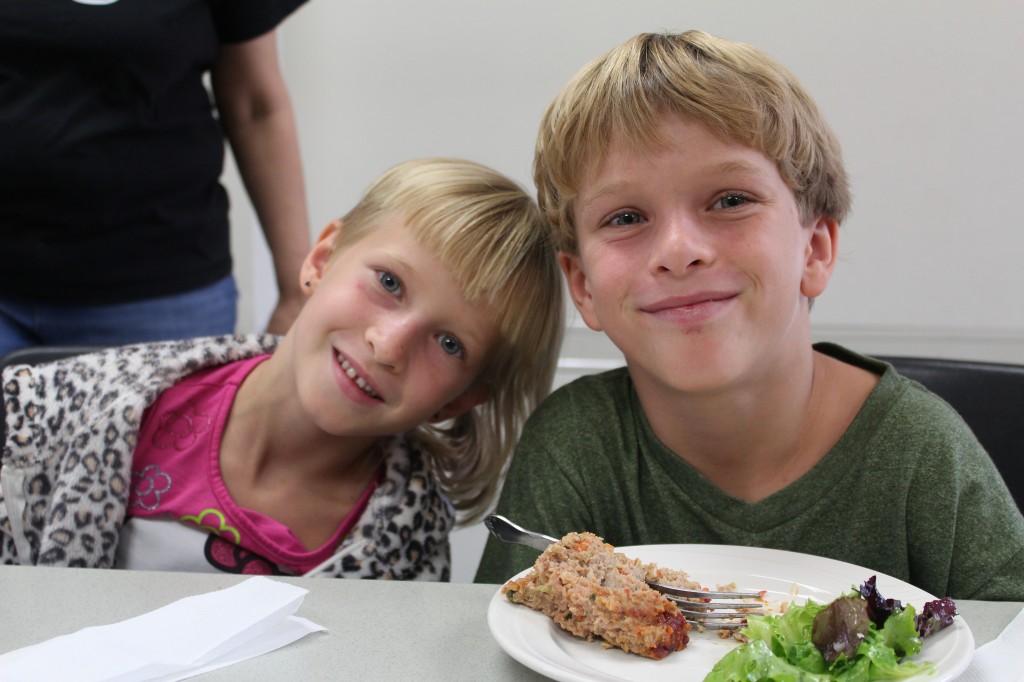 A whole food, also known as an intact food, is a foodstuff that is in its natural, unaltered state, unrefined state, i.e., brown rice, not white rice. Whole foods offer the health-supporting nutrients required for optimum health and should be a part of everyone’s diet. Avoid processed foods and consume nutrient-dense whole foods.
A whole food, also known as an intact food, is a foodstuff that is in its natural, unaltered state, unrefined state, i.e., brown rice, not white rice. Whole foods offer the health-supporting nutrients required for optimum health and should be a part of everyone’s diet. Avoid processed foods and consume nutrient-dense whole foods.









